disruptor笔记之六:常见场景
欢迎访问我的GitHub
https://github.com/zq2599/blog_demos
内容:所有原创文章分类汇总及配套源码,涉及Java、Docker、Kubernetes、DevOPS等;
《disruptor笔记》系列链接
- 快速入门
- Disruptor类分析
- 环形队列的基础操作(不用Disruptor类)
- 事件消费知识点小结
- 事件消费实战
- 常见场景
- 等待策略
- 知识点补充(终篇)
本篇概览
- 本文是《disruptor笔记》系列的第六篇,主要内容是将一些常用的消费模式做汇总,后续日常开发中如果有需要就能拿来即用;
- 以下是常用的模式:
- 多个消费者独立消费,前文已实现,本篇跳过
- 多个消费者共同消费,前文已实现,本篇跳过
- 既有独立消费,也有共同消费,前文已实现,本篇跳过
- 多个生产者和多个独立消费者:
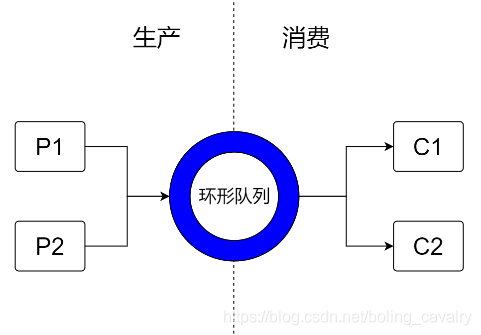
- C1、C2独立消费,C3依赖C1和C2
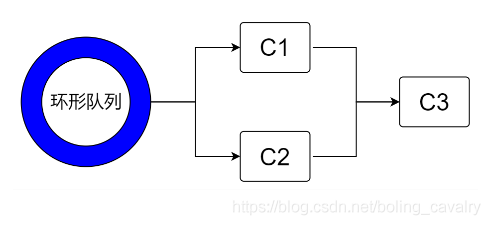
- C1独立消费,C2和C3也独立消费,但依赖C1,C4依赖C2和C3:
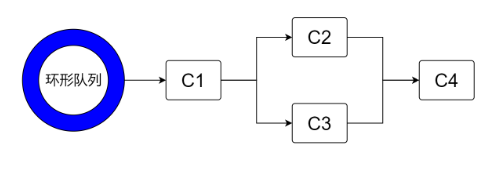
- C1和C2独立消费,C3和C4也是独立消费,但C3和C4都依赖C1和C2,然后C5依赖C3和C4:
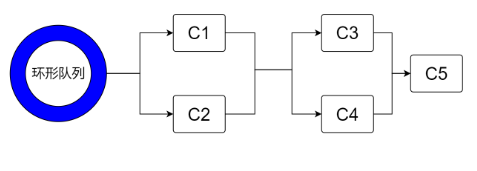
- C1和C2共同消费,C3和C4也是共同消费,但C3和C4都依赖C1和C2,然后C5依赖C3和C4:
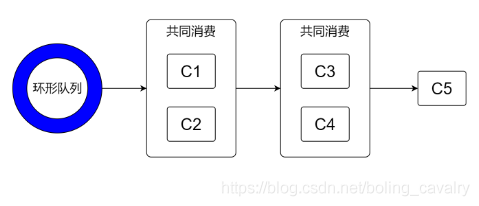
- C1和C2共同消费,C3和C4独立消费,但C3和C4都依赖C1和C2,然后C5依赖C3和C4:

- C1和C2独立消费,C3和C4是共同消费,但C3和C4都依赖C1和C2,然后C5依赖C3和C4:

关于本篇代码
- 为了省事儿,本次不会新建工程,而是直接使用前文的consume-mode模块,因此,下面这些类直接就直接使用了,无需重写代码:
- 事件定义:OrderEvent
- 事件工厂:OrderEventFactory
- 事件生产者:OrderEventProducer
- 用在独立消费场景的事件消费者:MailEventHandler
- 用在共同消费场景的事件消费者:MailWorkHandler
源码下载
- 本篇实战中的完整源码可在GitHub下载到,地址和链接信息如下表所示(https://github.com/zq2599/blog_demos):
| 名称 | 链接 | 备注 |
|---|---|---|
| 项目主页 | https://github.com/zq2599/blog_demos | 该项目在GitHub上的主页 |
| git仓库地址(https) | https://github.com/zq2599/blog_demos.git | 该项目源码的仓库地址,https协议 |
| git仓库地址(ssh) | git@github.com:zq2599/blog_demos.git | 该项目源码的仓库地址,ssh协议 |
- 这个git项目中有多个文件夹,本次实战的源码在disruptor-tutorials文件夹下,如下图红框所示:

- disruptor-tutorials是个父工程,里面有多个module,本篇实战的module是consume-mode,如下图红框所示:

多个生产者和多个独立消费者
咱们即将实现下图的逻辑:

- 前面几篇文章所有实战的生产者都只有一个,到了本篇,为了让consume-mode模块的代码能够支持多生产者,咱们要对功能业务的抽象父类做以下两处改动:
-
init方法原本为private型,现在为了能让子类重此方法,将其改为protected类型;
-
增加名为publishWithProducer2的方法,可见内部只有抛出异常,要想其正常工作,需要子类自己来实现:
public void publishWithProducer2(String value) throws Exception {
throw new Exception("父类未实现此方法,请在子类中重写此方法后再调用");
}
- 为了实现多生产者功能,新增MultiProducerServiceImpl.java,有几处要注意的地方稍后会提到:
package com.bolingcavalry.service.impl;
import com.bolingcavalry.service.*;
import com.lmax.disruptor.BlockingWaitStrategy;
import com.lmax.disruptor.dsl.Disruptor;
import com.lmax.disruptor.dsl.ProducerType;
import lombok.Setter;
import org.springframework.scheduling.concurrent.CustomizableThreadFactory;
import org.springframework.stereotype.Service;
import javax.annotation.PostConstruct;
@Service("multiProducerService")
public class MultiProducerServiceImpl extends ConsumeModeService {
/**
* 第二个生产者
*/
@Setter
protected OrderEventProducer producer2;
@PostConstruct
@Override
protected void init() {
// 实例化
disruptor = new Disruptor<>(new OrderEventFactory(),
BUFFER_SIZE,
new CustomizableThreadFactory("event-handler-"),
// 生产类型是多生产者
ProducerType.MULTI,
// BlockingWaitStrategy是默认的等待策略
new BlockingWaitStrategy());
// 留给子类实现具体的事件消费逻辑
disruptorOperate();
// 启动
disruptor.start();
// 第一个生产者
setProducer(new OrderEventProducer(disruptor.getRingBuffer()));
// 第二个生产者
setProducer2(new OrderEventProducer(disruptor.getRingBuffer()));
}
@Override
protected void disruptorOperate() {
// 一号消费者
MailEventHandler c1 = new MailEventHandler(eventCountPrinter);
// 二号消费者
MailEventHandler c2 = new MailEventHandler(eventCountPrinter);
// 调用handleEventsWithWorkerPool,表示创建的多个消费者以共同消费的模式消费
disruptor.handleEventsWith(c1, c2);
}
@Override
public void publishWithProducer2(String value) throws Exception {
producer2.onData(value);
}
}
- 上述代码有以下几处要注意:
- 重写父类的init方法,主要是实例化Disruptor的时候,多传入两个参数:ProducerType.MULTI表示生产类型是多生产者,BlockingWaitStrategy是等待策略,之前的代码中咱们没有传此参数时,默认的就是BlockingWaitStrategy
- init方法中还执行了setProducer2方法,设置成员变量producer2
- 重写publishWithProducer2方法,调用成员变量producer2发表事件
- 重写disruptorOperate方法,里面设置了两个独立消费者
- 验证上述代码的方式依旧是单元测试,打开ConsumeModeServiceTest.java,新增以下代码,可见新增了两个线程同时执行发布事件的操作:
@Autowired
@Qualifier("multiProducerService")
ConsumeModeService multiProducerService;
@Test
public void testMultiProducerService() throws InterruptedException {
log.info("start testMultiProducerService");
CountDownLatch countDownLatch = new CountDownLatch(1);
// 两个生产者,每个生产100个事件,一共生产两百个事件
// 两个独立消费者,每人消费200个事件,因此一共消费400个事件
int expectEventCount = EVENT_COUNT*4;
// 告诉service,等消费到400个消息时,就执行countDownLatch.countDown方法
multiProducerService.setCountDown(countDownLatch, expectEventCount);
// 启动一个线程,用第一个生产者生产事件
new Thread(() -> {
for(int i=0;i<EVENT_COUNT;i++) {
log.info("publich {}", i);
multiProducerService.publish(String.valueOf(i));
}
}).start();
// 再启动一个线程,用第二个生产者生产事件
new Thread(() -> {
for(int i=0;i<EVENT_COUNT;i++) {
log.info("publishWithProducer2 {}", i);
try {
multiProducerService.publishWithProducer2(String.valueOf(i));
} catch (Exception e) {
e.printStackTrace();
}
}
}).start();
// 当前线程开始等待,前面的service.setCountDown方法已经告诉过service,
// 等消费到expectEventCount个消息时,就执行countDownLatch.countDown方法
// 千万注意,要调用await方法,而不是wait方法!
countDownLatch.await();
// 消费的事件总数应该等于发布的事件数
assertEquals(expectEventCount, multiProducerService.eventCount());
}
- 测试结果如下,测试通过,符合预期:

C1、C2独立消费,C3依赖C1和C2
- 逻辑图如下:

- 实现代码如下,非常简单,依赖关系用then即可实现:
package com.bolingcavalry.service.impl;
import com.bolingcavalry.service.ConsumeModeService;
import com.bolingcavalry.service.MailEventHandler;
import com.bolingcavalry.service.MailWorkHandler;
import com.bolingcavalry.service.SmsEventHandler;
import org.springframework.stereotype.Service;
@Service("scene5")
public class Scene5 extends ConsumeModeService {
@Override
protected void disruptorOperate() {
MailEventHandler c1 = new MailEventHandler(eventCountPrinter);
MailEventHandler c2 = new MailEventHandler(eventCountPrinter);
MailEventHandler c3 = new MailEventHandler(eventCountPrinter);
disruptor
// C1、C2独立消费
.handleEventsWith(c1, c2)
// C3依赖C1和C2
.then(c3);
}
}
- 单元测试代码:
@Autowired
@Qualifier("scene5")
Scene5 scene5;
@Test
public void testScene5 () throws InterruptedException {
log.info("start testScene5");
testConsumeModeService(scene5,
EVENT_COUNT,
// 三个独立消费者,一共消费300个事件
EVENT_COUNT * 3);
}
- 为了节省篇幅,测试结果就不贴了,要注意的是,每个事件都一定是C1和C2先消费过,才会被C3消费到;
C1独立消费,C2和C3也独立消费,但依赖C1,C4依赖C2和C3
- 逻辑图如下:

- 实现代码如下:
package com.bolingcavalry.service.impl;
import com.bolingcavalry.service.ConsumeModeService;
import com.bolingcavalry.service.MailEventHandler;
import org.springframework.stereotype.Service;
@Service("scene6")
public class Scene6 extends ConsumeModeService {
@Override
protected void disruptorOperate() {
MailEventHandler c1 = new MailEventHandler(eventCountPrinter);
MailEventHandler c2 = new MailEventHandler(eventCountPrinter);
MailEventHandler c3 = new MailEventHandler(eventCountPrinter);
MailEventHandler c4 = new MailEventHandler(eventCountPrinter);
disruptor
// C1
.handleEventsWith(c1)
// C2和C3也独立消费
.then(c2, c3)
// C4依赖C2和C3
.then(c4);
}
}
- 单元测试代码:
@Autowired
@Qualifier("scene6")
Scene6 scene6;
@Test
public void testScene6 () throws InterruptedException {
log.info("start testScene6");
testConsumeModeService(scene6,
EVENT_COUNT,
// 四个独立消费者,一共消费400个事件
EVENT_COUNT * 4);
}
C1和C2独立消费,C3和C4也是独立消费,但C3和C4都依赖C1和C2,然后C5依赖C3和C4
- 逻辑图如下:

- 实现代码如下:
package com.bolingcavalry.service.impl;
import com.bolingcavalry.service.ConsumeModeService;
import com.bolingcavalry.service.MailEventHandler;
import org.springframework.stereotype.Service;
@Service("scene7")
public class Scene7 extends ConsumeModeService {
@Override
protected void disruptorOperate() {
MailEventHandler c1 = new MailEventHandler(eventCountPrinter);
MailEventHandler c2 = new MailEventHandler(eventCountPrinter);
MailEventHandler c3 = new MailEventHandler(eventCountPrinter);
MailEventHandler c4 = new MailEventHandler(eventCountPrinter);
MailEventHandler c5 = new MailEventHandler(eventCountPrinter);
disruptor
// C1和C2独立消费
.handleEventsWith(c1, c2)
// C3和C4也是独立消费,但C3和C4都依赖C1和C2
.then(c3, c4)
// 然后C5依赖C3和C4
.then(c5);
}
}
- 单元测试代码:
@Autowired
@Qualifier("scene7")
Scene7 scene7;
@Test
public void testScene7 () throws InterruptedException {
log.info("start testScene7");
testConsumeModeService(scene7,
EVENT_COUNT,
// 五个独立消费者,一共消费500个事件
EVENT_COUNT * 5);
}
C1和C2共同消费,C3和C4也是共同消费,但C3和C4都依赖C1和C2,然后C5依赖C3和C4
- 逻辑图如下:

- 实现代码如下:
package com.bolingcavalry.service.impl;
import com.bolingcavalry.service.ConsumeModeService;
import com.bolingcavalry.service.MailEventHandler;
import com.bolingcavalry.service.MailWorkHandler;
import org.springframework.stereotype.Service;
/**
* @author will (zq2599@gmail.com)
* @version 1.0
* @description: C1和C2共同消费,C3和C4也是共同消费,但C3和C4都依赖C1和C2,然后C5依赖C3和C4
* @date 2021/5/23 11:05
*/
@Service("scene8")
public class Scene8 extends ConsumeModeService {
@Override
protected void disruptorOperate() {
MailWorkHandler c1 = new MailWorkHandler(eventCountPrinter);
MailWorkHandler c2 = new MailWorkHandler(eventCountPrinter);
MailWorkHandler c3 = new MailWorkHandler(eventCountPrinter);
MailWorkHandler c4 = new MailWorkHandler(eventCountPrinter);
MailWorkHandler c5 = new MailWorkHandler(eventCountPrinter);
disruptor
// C1和C2共同消费
.handleEventsWithWorkerPool(c1, c2)
// C3和C4也是独立消费,但C3和C4都依赖C1和C2
.thenHandleEventsWithWorkerPool(c3, c4)
// 然后C5依赖C3和C4
.thenHandleEventsWithWorkerPool(c5);
}
}
- 单元测试代码:
@Autowired
@Qualifier("scene8")
Scene8 scene8;
@Test
public void testScene8 () throws InterruptedException {
log.info("start testScene8");
testConsumeModeService(scene8,
EVENT_COUNT,
// C1和C2共同消费,C3和C4共同消费,C5虽然只是一个,但也是共同消费模式,
// 也就是一共有三组消费者,所以一共消费300个事件
EVENT_COUNT * 3);
}
C1和C2共同消费,C3和C4独立消费,但C3和C4都依赖C1和C2,然后C5依赖C3和C4
- 逻辑图如下:

- 实现代码如下:
package com.bolingcavalry.service.impl;
import com.bolingcavalry.service.ConsumeModeService;
import com.bolingcavalry.service.MailEventHandler;
import com.bolingcavalry.service.MailWorkHandler;
import org.springframework.stereotype.Service;
@Service("scene9")
public class Scene9 extends ConsumeModeService {
@Override
protected void disruptorOperate() {
MailWorkHandler c1 = new MailWorkHandler(eventCountPrinter);
MailWorkHandler c2 = new MailWorkHandler(eventCountPrinter);
MailEventHandler c3 = new MailEventHandler(eventCountPrinter);
MailEventHandler c4 = new MailEventHandler(eventCountPrinter);
MailEventHandler c5 = new MailEventHandler(eventCountPrinter);
disruptor
// C1和C2共同消费
.handleEventsWithWorkerPool(c1, c2)
// C3和C4独立消费,但C3和C4都依赖C1和C2
.then(c3, c4)
// 然后C5依赖C3和C4
.then(c5);
}
}
- 单元测试代码:
@Autowired
@Qualifier("scene9")
Scene9 scene9;
@Test
public void testScene9 () throws InterruptedException {
log.info("start testScene9");
testConsumeModeService(scene9,
EVENT_COUNT,
// C1和C2共同消费(100个事件),
// C3和C4独立消费(200个事件),
// C5独立消费(100个事件),
// 所以一共消费400个事件
EVENT_COUNT * 4);
}
C1和C2独立消费,C3和C4是共同消费,但C3和C4都依赖C1和C2,然后C5依赖C3和C4
- 逻辑图如下:

- 实现代码如下:
package com.bolingcavalry.service.impl;
import com.bolingcavalry.service.ConsumeModeService;
import com.bolingcavalry.service.MailEventHandler;
import com.bolingcavalry.service.MailWorkHandler;
import org.springframework.stereotype.Service;
@Service("scene10")
public class Scene10 extends ConsumeModeService {
@Override
protected void disruptorOperate() {
MailEventHandler c1 = new MailEventHandler(eventCountPrinter);
MailEventHandler c2 = new MailEventHandler(eventCountPrinter);
MailWorkHandler c3 = new MailWorkHandler(eventCountPrinter);
MailWorkHandler c4 = new MailWorkHandler(eventCountPrinter);
MailEventHandler c5 = new MailEventHandler(eventCountPrinter);
disruptor
// C1和C2共同消费
.handleEventsWith(c1, c2)
// C3和C4是共同消费,但C3和C4都依赖C1和C2
.thenHandleEventsWithWorkerPool(c3, c4)
// 然后C5依赖C3和C4
.then(c5);
}
}
- 单元测试代码:
@Test
public void testScene10 () throws InterruptedException {
log.info("start testScene10");
testConsumeModeService(scene10,
EVENT_COUNT,
// C1和C2独立消费(200个事件),
// C3和C4共同消费(100个事件),
// C5独立消费(100个事件),
// 所以一共消费400个事件
EVENT_COUNT * 4);
}
- 至此,一些常见场景的代码已完成,希望本文能给您一些参考,帮您更得心应手的用好这个优秀的工具;
你不孤单,欣宸原创一路相伴
- Java系列
- Spring系列
- Docker系列
- kubernetes系列
- 数据库+中间件系列
- DevOps系列
欢迎关注公众号:程序员欣宸
微信搜索「程序员欣宸」,我是欣宸,期待与您一同畅游Java世界…
https://github.com/zq2599/blog_demos


